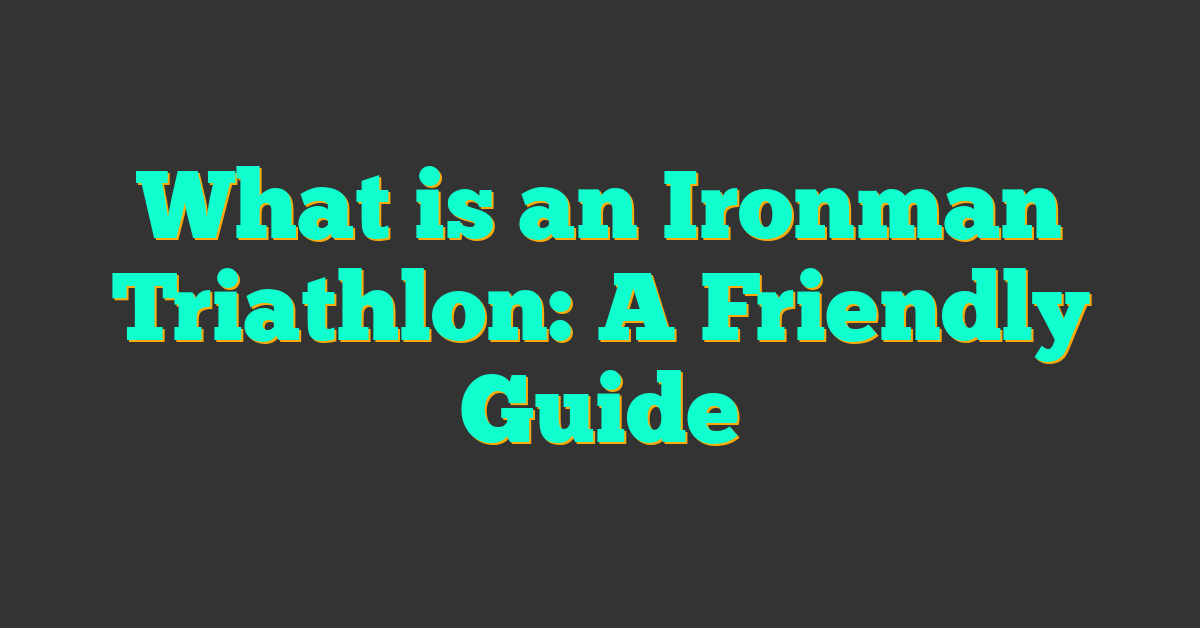An Ironman Triathlon is one of the most challenging endurance races in the world. It consists of a 2.4-mile (3.9 km) swim, a 112-mile (180.2 km) bicycle ride, and a marathon 26.22-mile (42.2 km) run, completed in that order. The total distance covered is 140.6 miles (226.3 km), and athletes have a maximum of 17 hours to finish the race.

The Ironman Triathlon is not just a race, but it’s also an internationally recognized brand. The World Triathlon Corporation (WTC) organizes the race series, and it hosts both full and half-Ironman events worldwide. The Ironman brand has become synonymous with endurance and resilience, and it attracts thousands of participants every year who aim to push their limits and achieve their personal bests.
Key Takeaways
- The Ironman Triathlon is a grueling endurance race that consists of a 2.4-mile swim, a 112-mile bicycle ride, and a marathon 26.22-mile run, completed in that order.
- The World Triathlon Corporation (WTC) organizes the Ironman race series, which has become an internationally recognized brand.
- The Ironman Triathlon attracts thousands of athletes every year who aim to push their limits and achieve their personal bests.
Understanding the Ironman Triathlon
If you’re looking for the ultimate test of endurance, the Ironman Triathlon is the perfect challenge for you. The Ironman Triathlon is a multisport endurance race that involves swimming, cycling, and running. It is a full-distance race that covers 140.6 miles, and it is considered one of the toughest endurance races in the world.

The Ironman Triathlon was first held in 1978 in Hawaii, and it has since become a global phenomenon. The race is organized by the World Triathlon Corporation (WTC), and it is held in various locations around the world. The race consists of a 2.4-mile swim, a 112-mile bike ride, and a marathon 26.2-mile run, all completed in that order.
The Ironman Triathlon is not for the faint of heart. It takes months of training and preparation to complete the race. The race can take an average athlete upwards of 12 or more hours to complete. However, the sense of accomplishment that comes with crossing the finish line is unparalleled.
To prepare for the Ironman Triathlon, you need to be in top physical condition. You need to have a strong cardiovascular system, excellent muscular endurance, and mental toughness. It is recommended that you train for at least six months before attempting the race.
During the race, you will need to pace yourself and conserve your energy. The swim is the first leg of the race, and it is followed by the bike ride and the run. It is essential to eat and drink during the race to maintain your energy levels.
In conclusion, the Ironman Triathlon is a grueling test of endurance that requires months of training and preparation. It is a full-distance race that covers 140.6 miles and involves swimming, cycling, and running. If you’re up for the challenge, the sense of accomplishment that comes with crossing the finish line is unparalleled.
History of the Ironman
If you’re interested in the history of the Ironman triathlon, you’re in for a treat. The Ironman triathlon started as a challenge between a group of friends in Hawaii in 1978. The first Ironman triathlon was held on February 18, 1978, on the island of Oahu.
The Ironman triathlon was the brainchild of John and Judy Collins, who moved from California to Hawaii in 1975. The Collins family had participated in the Mission Bay Triathlon in San Diego on September 25, 1974. That event now marks the start of modern triathlon in the U.S.
The first Ironman triathlon was a combination of three existing endurance races: the Waikiki Roughwater Swim (2.4 miles), the Around-Oahu Bike Race (112 miles), and the Honolulu Marathon (26.2 miles). The idea was to see who was the fittest athlete: the swimmer, the cyclist, or the runner.
The first Ironman triathlon had only 15 participants, and it was won by Gordon Haller, who finished the race in 11 hours, 46 minutes, and 58 seconds. The race was so tough that only 12 of the 15 participants finished the race.
Over the years, the Ironman triathlon has become one of the most popular and grueling endurance races in the world. The race has produced many legendary athletes, including Dave Scott, Mark Allen, Julie Moss, and Lyn Lemaire. The Ironman also has a rich history of race directors, including Valerie Silk and Kathleen McCartney.
If you’re interested in learning more about the history of the Ironman triathlon, there are many books and documentaries available that cover the topic in detail.
The Ironman Race Structure
If you are considering participating in an Ironman race, it is essential to understand the race structure. The Ironman race is a long-distance triathlon that comprises three continuous and sequential disciplines; swimming, cycling, and running.
Swim
The Ironman race starts with a 2.4-mile (3.9 km) swim, which is usually an open water swim. The swim course is usually marked with buoys, and swimmers are required to follow the course. It is essential to note that the swim segment is not only about speed but also about endurance. Therefore, it is advisable to pace yourself and conserve your energy for the remaining segments.
Bike
After completing the swim segment, you will transition to the bike segment. The bike segment is a 112-mile (180.2 km) ride, and it involves a lot of hills and turns. Therefore, it is essential to have good bike handling skills and be able to navigate through the course safely. It is also essential to note that drafting is not allowed in the Ironman race, so you should maintain a safe distance from other riders.
Run
After completing the bike segment, you will transition to the run segment. The run segment is a full marathon, which is 26.2 miles (42.2 km). It is essential to pace yourself during the run segment, especially if you have never run a marathon before. It is also essential to stay hydrated and take in some nutrition during the run segment to maintain your energy levels.
Transition
The transitions, also known as T1 and T2, are the periods between the swim and bike segment and the bike and run segment, respectively. During the transitions, you will change your gear, which includes changing from your wetsuit to cycling gear during T1 and from cycling gear to running gear during T2. It is essential to practice your transitions before the race to ensure that you can do them quickly and efficiently.
Half Ironman
If you are not ready for the full Ironman distance, you can participate in a half Ironman race. A half Ironman race involves a 1.2-mile (1.9 km) swim, a 56-mile (90 km) bike ride, and a 13.1-mile (21.1 km) run. The race structure is similar to that of the full Ironman race, but the distances are shorter.
In summary, the Ironman race structure involves swimming, cycling, and running segments, with transitions between each segment. The race is a test of endurance and requires proper training and preparation.
Major Ironman Events
If you are interested in participating in an Ironman triathlon, there are many events that take place throughout the year. The most famous of these is the Ironman World Championship, held annually in Kona, Hawaii. This event is considered the pinnacle of Ironman racing and is the ultimate goal for many triathletes.
« Can You Do a Triathlon with a Mountain Bike? Tips and Tricks for Success
Triathlon Distances: A Quick Guide to Race Lengths »
Another popular Ironman event is the Ironman 70.3, which is a half-distance version of the full Ironman race. These races are held all over the world and are a great way to get a taste of Ironman racing without committing to the full distance.
The World Championships are also a major event in the Ironman calendar. These championships are held by the International Triathlon Union (ITU) and attract the best triathletes from around the world.
The Ironman Group, which is owned by the World Triathlon Corporation (WTC), is responsible for organizing most of the Ironman races around the world. Some of the most popular Ironman races include Ironman Arizona and Ironman Mont-Tremblant.
Overall, Ironman racing is a challenging and rewarding experience. Whether you are a seasoned pro or a beginner, there is an Ironman event that is right for you. So why not challenge yourself and sign up for an Ironman race today?
Training for an Ironman
Training for an Ironman triathlon is a significant undertaking that requires discipline, dedication, and a well-planned training plan. To prepare for the race, you need to focus on building endurance, strength, and mental toughness. You should start training at least six months before the race day to give yourself enough time to prepare.
Building Endurance
Building endurance is a crucial aspect of Ironman training. You need to be able to swim 2.4 miles, bike 112 miles, and run 26.2 miles without stopping. To build endurance, you need to gradually increase the duration and intensity of your workouts. You should aim to train for at least 10-15 hours per week, with a mix of swimming, biking, and running.
Strength Training
In addition to endurance training, you also need to focus on strength training. Strength training helps you build muscle, improve your posture, and prevent injuries. You should aim to strength train at least two times per week, focusing on exercises that target your core, legs, and upper body.
Mental Toughness
Ironman training is not just about physical strength; it also requires mental toughness. You need to be able to push through pain, fatigue, and discomfort to reach the finish line. To build mental toughness, you should practice visualization, positive self-talk, and pacing strategies.
Pacing and Nutrition
Pacing and nutrition are also crucial aspects of Ironman training. You need to be able to pace yourself throughout the race to avoid burning out too quickly. You should also pay attention to your nutrition, making sure you consume enough calories and fluids to sustain your energy levels throughout the race.
In summary, Ironman training requires discipline, dedication, and a well-planned training plan. You need to focus on building endurance, strength, and mental toughness, while also paying attention to pacing and nutrition. With consistent training and a positive mindset, you can successfully complete an Ironman triathlon and achieve your fitness goals.
Ironman Locations and Terrains
Ironman triathlons are held in various locations around the world, each with its unique terrain and atmosphere. Some of the most famous Ironman locations include Hawaii, France, Tempe, Nice, Utah, Canada, North America, Kailua-Kona, Big Island, United States, Cairns, Kalmar, Thun, Oahu, Hāwī, and Keauhou.
The Ironman World Championship in Kailua-Kona, Hawaii, is perhaps the most famous Ironman event. This race takes place on the Big Island and features a challenging course that includes a swim in the Pacific Ocean, a bike ride through lava fields, and a run that finishes in downtown Kailua-Kona.
Nice, France, is another popular Ironman location. The race here takes place along the French Riviera and features a scenic course that includes a swim in the Mediterranean Sea, a bike ride through the mountains, and a run along the Promenade des Anglais.
Tempe, Arizona, hosts the Ironman Arizona event, which takes place in November. The race includes a swim in Tempe Town Lake, a bike ride through the Sonoran Desert, and a run along the Tempe Canal Path.
Ironman Canada takes place in Penticton, British Columbia. This race includes a swim in Okanagan Lake, a bike ride through the mountains, and a run that finishes in downtown Penticton.
Ironman North America Series features races in various locations across the United States, including Lake Placid, New York; Santa Rosa, California; and Chattanooga, Tennessee. Each race offers its unique terrain and atmosphere, from the rolling hills of Lake Placid to the scenic vineyards of Santa Rosa.
Ironman Cairns in Australia takes place in the tropical paradise of Cairns, Queensland. The race includes a swim in the Coral Sea, a bike ride through the rainforest, and a run that finishes in downtown Cairns.
Ironman Kalmar in Sweden takes place in the charming coastal town of Kalmar. The race includes a swim in the Baltic Sea, a bike ride through the countryside, and a run that finishes in the town square.
Ironman Switzerland in Thun is another scenic race that takes place in the heart of the Swiss Alps. The race includes a swim in Lake Thun, a bike ride through the mountains, and a run that finishes in downtown Thun.
Whether you are a seasoned Ironman athlete or a first-time competitor, each location offers a unique challenge and experience. From the mountains of Utah to the beaches of Oahu, there is an Ironman race for everyone.
Ironman Rules and Regulations
Participating in an Ironman Triathlon requires a significant commitment of time and effort. The race is governed by strict rules and regulations to ensure a fair and safe competition for all athletes. Here are some of the key rules and regulations you should be aware of before you sign up for an Ironman race.
Time Limit and Cutoff Times
Ironman races have a strict time limit of 17 hours from the start of the race to the finish line. This means you must complete the 2.4-mile swim, 112-mile bike ride, and 26.2-mile run within this time frame. There are also cutoff times for each leg of the race that you must meet to continue on to the next leg. These cutoff times are designed to ensure your safety and prevent you from overexerting yourself.
Race Time
Your race time begins as soon as you cross the start line, and it ends when you cross the finish line. This means that any time you spend in transition areas or taking breaks during the race will count towards your overall race time. It’s important to keep this in mind when planning your race strategy and pacing yourself throughout the event.
Rules
Ironman races have a set of rules that all athletes must follow. These rules cover everything from equipment to conduct during the race. Some of the key rules include wearing a wetsuit during the swim if the water temperature is below a certain level, using a bike helmet that meets certain safety standards during the bike ride, and refraining from drafting or blocking other athletes during the race.
Commitment
Participating in an Ironman Triathlon requires a significant commitment of time and effort. You’ll need to train for months leading up to the race to ensure you’re physically and mentally prepared for the challenge. You’ll also need to commit to a healthy diet and lifestyle to help you perform at your best on race day.
In summary, participating in an Ironman Triathlon requires a significant commitment of time and effort. The race is governed by strict rules and regulations to ensure a fair and safe competition for all athletes. It’s important to familiarize yourself with these rules and regulations before you sign up for an Ironman race to ensure you’re prepared for the challenge ahead.
Equipment for an Ironman
Preparing for an Ironman triathlon requires not only physical training but also having the right equipment. Here are some essential items you will need to have in order to tackle the race.
Wetsuit
A wetsuit is a must-have for the swim portion of the race. It provides buoyancy, warmth, and helps with hydrodynamics. Make sure to choose a wetsuit that fits you well and is comfortable to wear for an extended period of time.
Gel
Gels are a convenient and easy-to-digest source of energy during the race. They come in various flavors and can be consumed quickly, providing a boost of energy when you need it the most. Make sure to try different brands and flavors during your training to find the ones that work best for you.
Triathlon Bike
A triathlon bike is designed specifically for triathlons and can make a big difference in your performance. It is lighter, more aerodynamic, and has a more aggressive riding position than a regular road bike. Make sure to get a proper bike fit and practice riding in your triathlon position during your training.
Helmet
A helmet is a crucial safety item and is required during the bike portion of the race. Make sure to choose a helmet that fits you well and meets safety standards. It is also a good idea to practice putting on and taking off your helmet quickly during your training.
Race Belt
A race belt is a convenient way to carry your race number during the bike and run portions of the race. It eliminates the need to pin your number to your clothing and allows you to quickly transition between the two portions of the race.
Running Shoes
Running shoes are the most important piece of equipment for the run portion of the race. Make sure to choose a pair that fits you well and is comfortable to wear for an extended period of time. It is also a good idea to break them in during your training and have a spare pair ready just in case.
Nutrition Strategies for an Ironman
When it comes to an Ironman triathlon, proper nutrition is key to finishing strong. You’ll need to fuel your body with the right balance of carbohydrates, protein, and fats to keep you going through the grueling 2.4-mile swim, 112-mile bike ride, and 26.2-mile run. Here are some nutrition strategies to help you prepare for race day.
Plan Your Race Nutrition
Before the race, plan your nutrition strategy based on your body weight, sweat rate, and training intensity. Aim to consume 60-120 grams of carbohydrates per hour during the race, with more calories and fluids during the bike leg and fewer calories during the run portion of the event. Thirty to 50 percent of your calories consumed on the bike should come from solid foods [1].
Hydrate Properly
Proper hydration is critical to your performance. Drink fluids regularly during the race to replace fluids lost through sweat. A good rule of thumb is to drink 0.1 to 0.15 ounces of fluid per pound of body weight per hour of racing [2]. You can use apps like FulGaz to track your hydration and nutrition during training and racing.
Choose the Right Foods
Choose foods that are easy to digest and provide sustained energy. Some good options include bananas, energy bars, gels, sports drinks, and peanut butter and jelly sandwiches. Avoid high-fiber, high-fat, and spicy foods that can cause stomach upset. Also, experiment with different foods and drinks during training to see what works best for you.
Don’t Forget Electrolytes
Electrolytes are minerals that help regulate fluid balance and muscle function. Sodium, potassium, and magnesium are the most important electrolytes for endurance athletes. You can get electrolytes from sports drinks, gels, and electrolyte tablets. Make sure to consume enough electrolytes during the race to prevent cramping and dehydration.
In summary, proper nutrition is essential to your success in an Ironman triathlon. Plan your race nutrition, hydrate properly, choose the right foods, and don’t forget electrolytes. By following these strategies, you’ll be well-fueled and ready to tackle the race. Good luck!
The Ironman Brand
If you’re interested in triathlons, then you’ve probably heard of the Ironman brand. The Ironman brand is a trademark owned by the Ironman Group, which is a subsidiary of the World Triathlon Corporation. The Ironman brand is known for organizing some of the most challenging and prestigious triathlon events in the world.
The Ironman brand was founded in 1978 when a group of athletes decided to combine three existing endurance events into one race. The first Ironman race was held in Hawaii, and it consisted of a 2.4-mile swim, a 112-mile bike ride, and a 26.2-mile run. The race was a huge success, and it quickly became known as one of the most difficult endurance events in the world.
Today, the Ironman brand organizes over 150 qualifying races in more than 50 countries around the world. These races include both full-distance Ironman events and half-distance Ironman events, which are also known as Ironman 70.3 races.
The Ironman brand is known for its commitment to excellence and its dedication to creating a challenging and rewarding experience for athletes. Ironman races are known for their beautiful locations, tough courses, and incredible atmosphere. If you’re looking for a triathlon that will test your limits and push you to be your best, then the Ironman brand is definitely worth considering.
Frequently Asked Questions
What are the distances of a Half Ironman?
A Half Ironman, also known as a 70.3, consists of a 1.2-mile (1.9 km) swim, a 56-mile (90 km) bike ride, and a 13.1-mile (21.1 km) run. It is half the distance of a full Ironman triathlon.
What was the first Ironman race like?
The first Ironman race was held on February 18, 1978, in Hawaii. It was a challenge between three athletes who combined the Waikiki Roughwater Swim (2.4 miles / 3.86 km), the Around-Oahu Bike Race (112 miles / 180.25 km), and the Honolulu Marathon (26.2 miles / 42.2 km). The winner was Gordon Haller, who completed the race in 11 hours, 46 minutes, and 58 seconds.
What is the average time to complete an Ironman?
The average time to complete an Ironman triathlon varies depending on factors such as age, gender, fitness level, and course difficulty. According to Ironman, the average finishing time for a full Ironman is around 12 hours and 35 minutes for men and 13 hours and 19 minutes for women.
What are the cut-off times for a 70.3 Ironman?
The cut-off times for a 70.3 Ironman vary depending on the race course and location. However, the general rule is that athletes must complete the swim within 1 hour and 10 minutes, the bike within 5 hours and 30 minutes, and the entire race within 8 hours and 30 minutes.
What are the distances of a Super Ironman?
There is no such thing as a Super Ironman. The Ironman triathlon consists of a 2.4-mile (3.86 km) swim, a 112-mile (180.25 km) bike ride, and a 26.2-mile (42.2 km) run. This is the only official distance recognized by the World Triathlon Corporation.
What are some tips for training for an Ironman?
Training for an Ironman requires a lot of dedication, hard work, and time. Some tips to help you prepare for the race include setting realistic goals, following a structured training plan, focusing on nutrition and hydration, getting enough rest and recovery, and seeking professional guidance and support. It’s also important to listen to your body and avoid overtraining or pushing yourself too hard.










